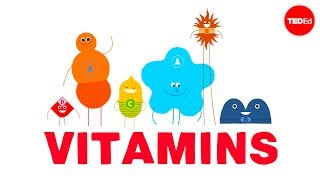(单词翻译:单击)
A, C, E, D, B, K. No, this isn't some random, out of order alphabet.
A,C,E,D,B,K,不,这不是随机、乱序的字母排序。
These are vitamins, and just like letters build words, they're the building blocks that keep the body running.
它们是维他命,就像单词是由字母来构成的一样,我们身体是要靠维他命延续的。
Vitamins are organic compounds we need to ingest in small amounts to keep functioning.
维他命是我们维系生命所需的微量有机混合物。
They're the body's builders, defenders and maintenance workers,
它们是身体的建造者、防御者、维护者,
helping it to build muscle and bone, make use of nutrients, capture and use energy and heal wounds.
帮助身体强筋健骨,利用营养物质,补充能量以及治疗伤口。
If you need convincing about vitamin value, just consider the plight of olden day sailors,
如果你需要让人来说服你维他命的价值,那就想一想过去水手们常有的难处,
who had no access to vitamin-rich fresh produce. They got scurvy.
他们无法获取含有丰富维他命的新鲜食物而得了坏血病。
But vitamin C, abundant in fruits and vegetables, was the simple antidote to this disease.
但是,果蔬中富含的维他命C正是此病的简单良药。
While bacteria, fungi and plants produce their own vitamins,
尽管细菌、真菌和植物都产生它们自身的维他命,
our bodies can't, so we have to get them from other sources.
人体却无法做到这一点,因此我们必须从其他渠道获得维他命。
So how does the body get vitamins from out there into here?
那么,人体是如何从外界获取维他命的呢?
That's dependent on the form these compounds take.
那要取决于这些混合物的形式。
Vitamins come in two types: lipid-soluble and water-soluble,
维他命往往分为两种类型,脂溶性的和水溶性的,
and the difference between them determines how the body transports and stores vitamins, and gets rid of the excess.
它们之间的区别决定了人体将如何运输、储藏维他命,并排出过量的维他命。
The water-solubles are vitamin C and B Complex vitamins that are made up of eight different types that each do something unique.
水溶性的便是维他命C和八种不同类型的B族维他命,每种类型都有其独特之处。
These are dissolved in the watery parts of fruits, vegetables and grains,
这两类维他命溶于水果、蔬菜、谷物的含水成分,
meaning their passage through the body is relatively straightforward.
也就意味着它们穿过身体的渠道是相对直截了当的。
Once inside the system, these foods are digested and the vitamins within them are taken up directly by the bloodstream.
一旦进入了人体系统,这些食物会被消化,而食物中的维他命就会直接进入血液循环。
Because blood plasma is water-based,
因为血浆的主要成分是水,
water-soluble vitamins C and B have their transport cut out for them and can move around freely within the body.
水溶性的维他命C和B族维他命有了专属的运输通道,并能在体内自由移动。
For lipid-soluble vitamins, dissolved in fat and found in foods like diary, butter and oils,
而脂溶性维他命则溶解在脂肪中,也能在乳制品、黄油和食用油中找到,
this trip into the blood is a little more adventurous.
它们进入人体的过程就稍为“惊险”一些。
These vitamins make it through the stomach and the intestine,
这些维他命通过胃和肠道,
where an acidic substance called bile flows in from the liver,
在此过程中,一种叫“胆汁”的酸性物质从肝脏中流入,
breaking up the fat and preparing it for absorption through the intestinal wall.
分解了脂肪,以备其在肠壁的消化。

Because fat-soluble vitamins can't make use of the blood's watery nature,
因为脂溶性维他命无法利用血液中含水的特质,
they need something else to move them around,
它们就需要另外的渠道才能进入人体,
and that comes from proteins that attach to the vitamins
这渠道就来自于附着在维他命上的蛋白质,
and act like couriers, transporting fat-solubles into the blood and around the body.
像速递一样将脂溶性维他命传输到血液和身体各处。
So, this difference between water- or fat-soluble vitamins determines how they get into the blood,
因此,水溶性和脂溶性维他命的区别决定了它们将如何进入血液,
but also how they're stored or rejected from the body.
但也决定了它们会如何被储存以及从身体中被排出。
The system's ability to circulate water-soluble vitamins in the bloodstream so easily
人体系统能够如此简单地传输水溶性维他命,
means that most of them can be passed out equally easily via the kidneys.
意味着它们大多数能够几乎同样简单地被排出肾脏。
Because of that, most water-soluble vitamins need to be replenished on a daily basis through the food we eat.
正因如此,大多水溶性维他命需要通过我们每天吃的食物被重新补充。
But fat-soluble vitamins have staying power because they can be packed into the liver and in fat cells.
但是脂溶性维他命能有持久力,因为它们能储存于我们的肝脏和脂肪细胞中。
The body treats these parts like a pantry,
这些器官相当于我们身体的储藏室,
storing the vitamins there and rationing them out when needed,
储藏着维他命,并将它们定额配给给身体,
meaning we shouldn't overload on this type of vitamin because the body is generally well stocked.
这意味着我们不应该过度摄入这类维他命,因为人体内通常有充沛的储存。
Once we figured the logistics of transport and storage,
我们一旦了解了维他命运输和储存的物流过程,
the vitamins are left to do the work they came here to do in the first place.
就能依靠维他命来完成它们原始的使命。
Some, like many of the B Complex vitamins, make up coenzymes,
有些维他命,比如B族,能生成辅酶,
whose job it is to help enzymes release the energy from food.
它帮助酶从食物中释放出能量。
Other B vitamins then help the body to use that energy.
其他B族维生素帮助身体利用这些能量。
From vitamin C, you get the ability to fight infection and make collagen,
从维生素C中,你能获取抗感染的能力并产生胶原蛋白,
a kind of tissue that forms bones and teeth and heals wounds.
生成骨骼、牙齿及治愈伤口。
Vitamin A helps make white blood cells, key in the body's defense,
维他命A有助于白血球的形成,它们是身体防御的关键,
helps shape bones and improves vision by keeping the cells of the eye in check.
帮助骨骼塑形,并通过控制眼球细胞来提高视力。
Vitamin D gathers calcium and phosphorus so we can make bones,
维他命D富含用于骨质生成的钙与磷,
and vitamin E works as an antioxidant, getting rid of elements in the body that can damage cells.
而维他命E则如同抗氧化剂,搞定体内损害细胞的成分。
Finally, from Vitamin K, we score the ability to clot blood, since it helps make the proteins that do this job.
最后,维他命K使我们获得凝血能力,因为它帮助生成蛋白质,而蛋白质负责凝血功能。
Without this vitamin variety, humans face deficiencies that cause a range of problems,
没有了这么多样化的维生素,人体将面临着各种各样的缺陷,会造成各种各样的健康问题,
like fatigue, nerve damage, heart disorders, or diseases like rickets and scurvy.
比如疲劳、神经受损、心律失常或者佝偻病和坏血病之类的疾病。
On the other hand, too much of any vitamin can cause toxicity in the body,
另一方面,过多的维他命会造成身体中毒,
so there goes the myth that loading yourself with supplements is a great idea.
因此“多多摄入维他命”这个点子究竟是好是坏,也就成了个谜。
In reality, it's all about getting the balance right, and hitting that vitamin jackpot.
实际上,最关键还是要保持营养均衡,让体内的维他命发挥最大功效。


